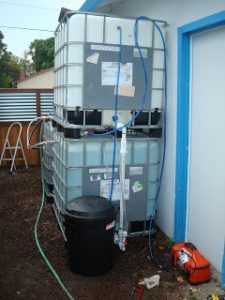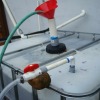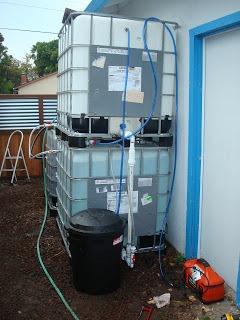
The second of Solar CITIES’ experimental all-climate biodigester. The first is in Egypt.
May 5, 2009
This system is built from three identical IDB tote HDPE tanks. To the rear, one can just make out the biodigester itself. The top of the digester is connected by 1/2 inch clear plastic tubing to the top-side of the water displacement tank (WDT) . Water from this tank is forced by gas coming from the digester out of a length of clear 1/2 inch plastic tubing from the bottom of this tank that loops over the top of the WDT into the sump. The sump is a 20-gallon plastic garbage bucket that can be seen in the foreground of the picture. The more gas is forced in, the more water is forced out until the sump is about 3/4 full. At this point a float switch turns on a pump inside the sump which carries the water up the blue 1/2 inch tube to the top of the water pressure tank (WPT). The pump is powered by a rechargeable battery with an inverter. It is the orange box in the bottom right of the photo. When the WDT is filled with gas and the WPT is filled with water, a valve in the one-inch white PVC pipe connecting the two is opened and the water pressure forces the gas out of the top of the WDT to the kitchen stove or barbecue via another 1/2 inch blue plastic tube.
From our Zabaleen Trash Recycler friends in Cairo we learned the truth of the adage, “waste not, want not”. Taking this concept to heart led to a trip to Pune, India where Dr. Anand Karve of the ARTI Institute taught us how to make simple biogas digesters that turn yesterday’s kitchen waste into today’s cooking gas. It is possible to get about two hours per 1000 liters per day from about two kg of stuff everybody else calls garbage. In addition to the clean burning gas, we get about 10 liters of liquid compost fertilizer which goes to the garden to make more nutritious and delicious food.
At 460 we have implemented the second “Solar CITIES cold-climate digester” based on a design T.H. Culhane came up with to take advantage of ubiquitous HDPE (“High Density Poly-Ethylene”) IBD (“Intermediate Bulk Delivery”) Tote Tanks (1000 liters or 275 gallons). As shown above, we also use two of these tanks for our greywater system. Other people recycled them for use in biodiesel systems. They make great trellises for plants and the sturdy metal frame are easy to climb on to do work without damaging the tanks. The frame also makes it easy to “roll” one into place. We had ours delivered on the street and T.H. rolled them down the block to get them in the back gate.
Besides making use of readily available recycled materials to build the digesters, the idea behind the design is to create a household-scale digester that can operate in cold climates. The normal cylindrical water tanks we use in Egypt (and which ARTI uses in India) are not readily available in Europe and America. Special ordered they can cost up to $500, while these used food and chemical containers can be had for 5 to 10 times less. So for low-cost systems these are the way to go.
The system Solar CITIES has designed is composed of three tanks. One, which is ground mounted, is the digester itself. Filled on the first day with about 40 kg of animal manure and 975 liters of water it is subsequently sealed. Because it is sealed, it can be insulated for outside use or placed indoors. The gas is piped to a second ground-mounted collection tank that is initially filled with 1000 liters of water to which ethylene glycol or some other anti-freeze additive can be added. This tank is sealed. As gas is created in the digester it builds up pressure, which forces it into the collection tank. As the sealed collection tank fills with gas, the gas displaces the water/anti-freeze mix via a looping tube into a 20 gallon sump. The sump is basically just a plastic trash can placed next to the collection tank. In the sump is a fractional horse-power garden pond pump and a float switch. When the sump fills about 3/4 full the sump pump goes on and pumps the water to an empty holding/pressure tank that is mounted above the collection tank and is open to atmospheric pressure via a small hole in the top. As gas fills the collection tank, the pressure tank fills with water. When one wants to use the gas in the kitchen or the barbecue one simply opens the valve to a 1 inch pipe that connects the two tanks. The water in the top tank then flows back into the bottom tank and forces the gas out the top through a tube to the stove.
With this design, the gas collection/water-displacement pressure part of the system can be kept outdoors in a safe location and remain uninsulated. The minimal energy requirements of the water pump can be handled by a solar-charged battery. In our case, we use an AC pump with an inverter but a DC pump can also be used directly.
Thus kitchen waste is directly turned into fossil fuel-free cooking gas and easily transportable liquid fertilizer. Smells, flies and rodents are also eliminated from the home and the other so-called “garbage” (paper, plastic, metal, glass) can be easily sorted and cleanly stored for recycling or sale.
Ironically the tanks shown below, which we purchased from a recycler in Santa Rosa we found on Craig’s List, had previously contained Kosher food-grade glycerin. We are sure this makes the methanogenic bacteria very happy!

The feedstock for our biogas digester is just ordinary organic wastes from the kitchen, ground up into a slurry with water using a typical insinkerator waste disposal unit. At 460 Lucas we are also implementing a compost bin but only for cellulosic and lignocellulosic material (wood chips, leaves, grass clippings), paper, cardboard, newspaper, paper towels, shredded junk mail, tea bags and hard pits of fruit). The compost bin, as we learned from our friends in Africa, uses aerobic microbes to create a nice healthy soil from stuff most people burn or bury in landfills. We are also putting in a composting toilet, which we learned about in rainforest areas in Belize and Brunei and then found could be implemented in urban areas when visiting Johannesburg, South Africa.

